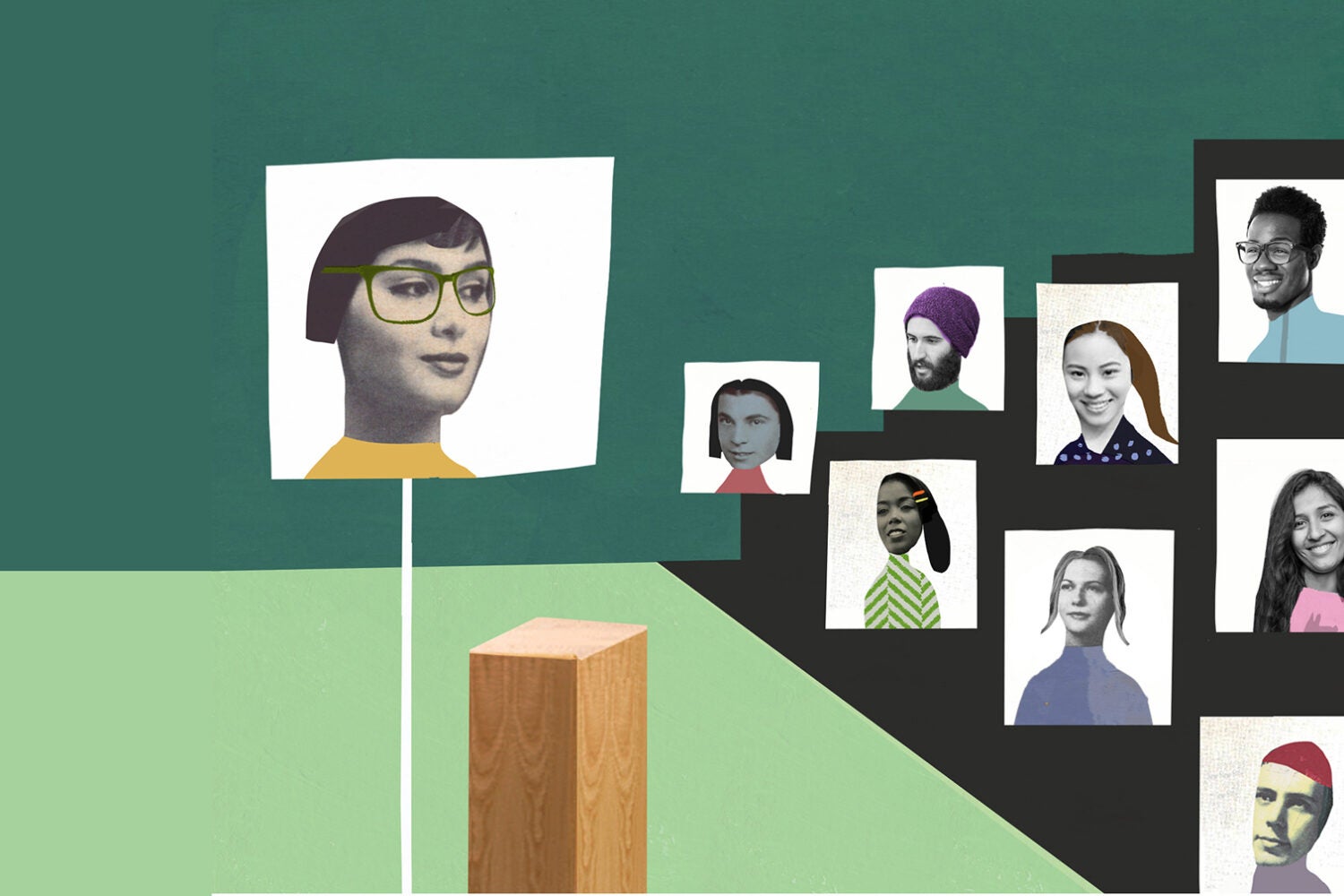In March, as the COVID-19 pandemic was rapidly escalating and an increasing number of businesses, schools, and other institutions were closing their doors to stop the spread of the virus, 1L Marisa Skillings headed to Cape Cod to spend spring break at her mother’s home. Just days before, Harvard President Larry Bacow had announced that the university would begin transitioning to all-virtual classes by March 23.
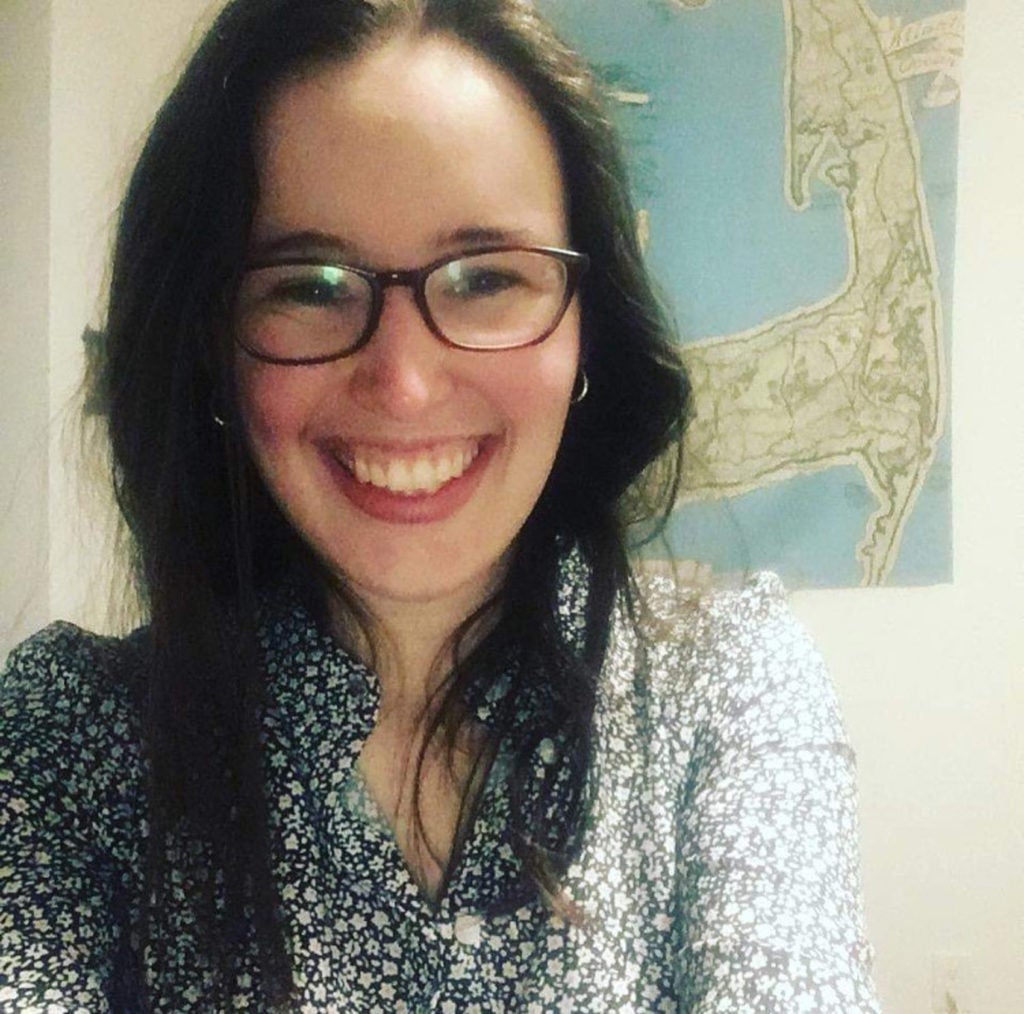
“I went off thinking naively, Oh, I’ll go back to campus at the end of break and it’ll be me and my friends doing classes online at each other’s houses,” recalled Skillings.
But as the commonwealth of Massachusetts went on near-lockdown, and President Bacow announced that students would not be able to return to campus after spring break, Skillings, along with the rest of the Harvard Law School and university communities, scrambled to adjust to a very different reality. “I kept extending my stay at my mom’s house—and now it’s been three months,” Skillings said in late May.
“It very quickly went from this is a thing that’s happening to everything is shutting down,” said Zak Lutz ’20, who spent the remainder of his final semester as a law school student hunkered down in his Cambridge apartment with several HLS roommates attending classes online.
In just 12 days, HLS moved its 260 spring courses and clinical offerings online.
In just 12 days, HLS moved its 260 spring courses and clinical offerings online. Faculty, long accustomed to lecturing before a classroom filled with students, had to make a fast switch to teaching from their homes via computer.
The week before spring break, HLS Professor Andrew Manuel Crespo ’08—who had 200 students in two courses and also directs the Impact Defense Initiative Clinic—learned that he and his wife, who also works full time and was nearing her due date for their second child, no longer had child care for their toddler. They found themselves teleworking from their small, two-bedroom apartment in Somerville while caring for their daughter and worrying about Crespo’s brother, a doctor on the front lines of the pandemic in Manhattan. That week, Crespo’s focus wasn’t on how to shift to online teaching. “My focus was trying to find a way to deal with all the difficult emotions going on among my students—and frankly, among us, too—and the day-to-day uncertainty of not realizing what it all meant,” he said.
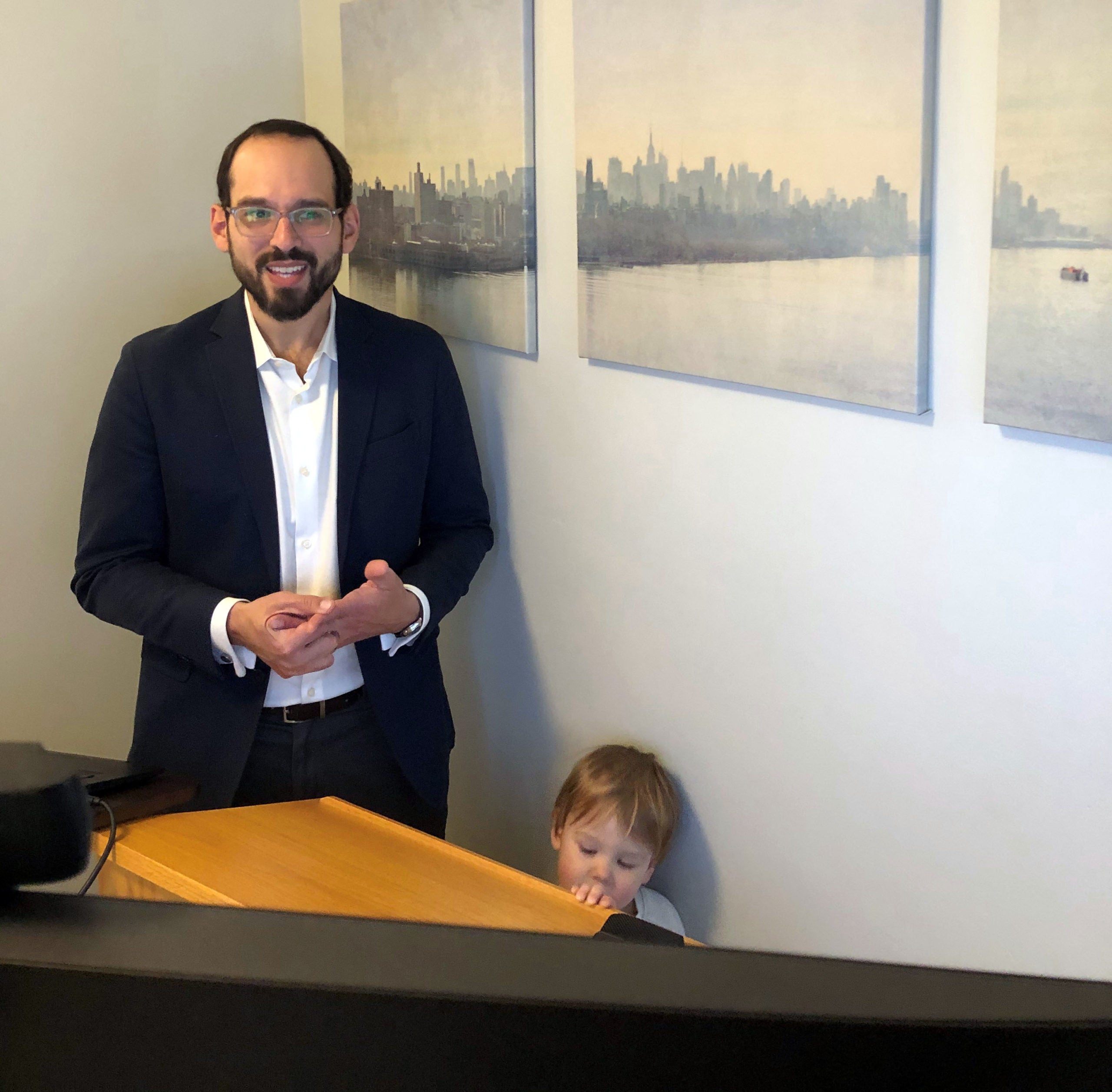
Before his students left campus for break, without a clear picture of what the rest of the school year would look like, Crespo wanted to create a sense of closure for the familiar way of in-person education. He made sure to acknowledge that “our shared experience—a significant part of it—was about to end.”
The technical aspects of switching to online classes turned out to be the easiest, students and faculty say. HLS quickly put online a series of resources for remote teaching and learning. Crespo himself created a detailed guide on teaching via Zoom for his colleagues—for instance, he recommends using two computer monitors, one set to gallery mode in order to see the facial expressions of 30 students at a time—and also drafted comprehensive instructions for students, including how to digitally raise their hands to ask questions.
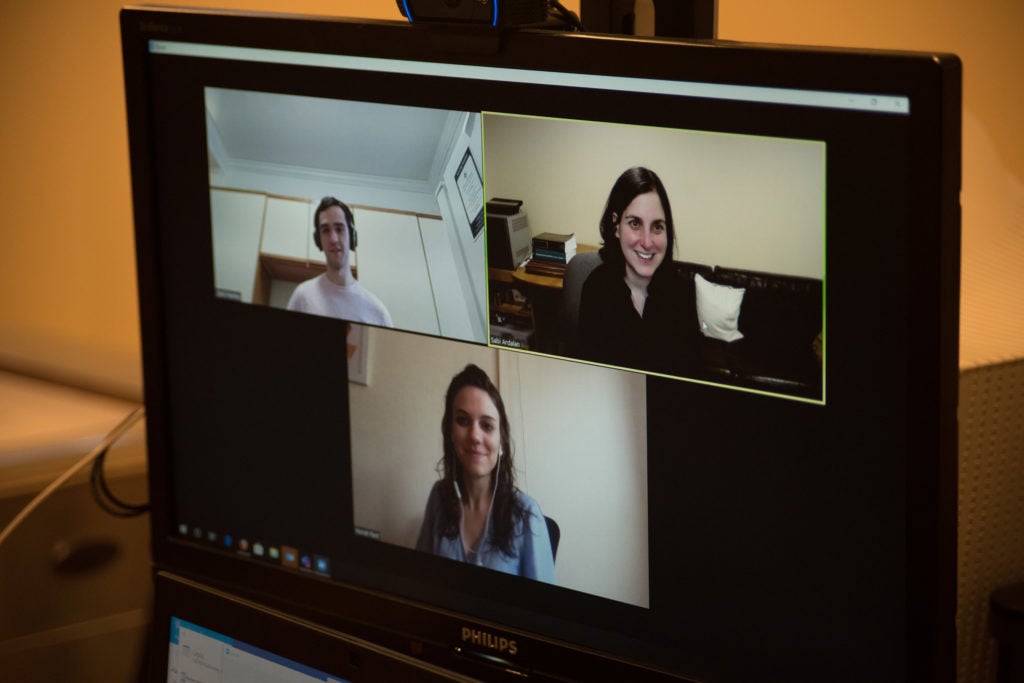
“I think we were braced for disaster and it actually wasn’t so bad,” said Clinical Professor Sabrineh Ardalan ’02, director of the Harvard Immigration and Refugee Clinical Program, who taught a clinical seminar and a classroom course. Since clinical students could no longer meet in person with clients, they leveraged technology to communicate in order to prepare affidavits and asylum applications and to check on clients who might need food or supplies. The clinic’s social worker regularly touched base with students to see how they were weathering the pandemic.
Professor Annette Gordon-Reed ’84, who co-taught a 12-student seminar, Constitutions, Law, and Empire, says that while face-to-face interaction with students is preferable, Zoom worked well and made it easier to hold appointments with students after class. Gordon-Reed taught online from Manhattan, where, in the early days of the pandemic, the sound of sirens was nonstop. One day, as she and her husband, Robert Reed ’81, a justice on the New York State Supreme Court, walked around Central Park, they witnessed tents newly erected in front of Mount Sinai Hospital for the overflow of COVID-19 patients. “It was surreal,” she said, “to know so many people are suffering around you, in close proximity to you.”

In the midst of so much uncertainty and difficulty, Crespo decided to make his teaching as familiar as possible. Though he taught from home, he stood in front of a podium and continued what he calls “Elizabeth Warren-style” teaching, with rapid-fire questioning (Warren, a former teacher of Crespo’s, was legendary at HLS for her ability to engage over 80 students in Socratic dialogue in each class). “When students clicked in and saw me, I wanted something almost at a subliminal level that their minds saw as familiar,” he said.
Professor Jeannie Suk Gersen found that teaching from home dissolved the traditional hierarchy between students and teachers.
But teaching from home—with Zoom capturing such personal moments as the sounds of children and pets—dissolved the traditional hierarchy between students and teachers, Professor Jeannie Suk Gersen ’02 found. In an April 23 essay for The New Yorker, she wrote of openly acknowledging her own fear and distress to her students, and recognizing theirs, thus “melting the professional and emotional distance that teaching law normally entails.” As a result, she found “something strangely more intimate about online teaching, which makes the attention to each student feel more live and personalized, not less.”
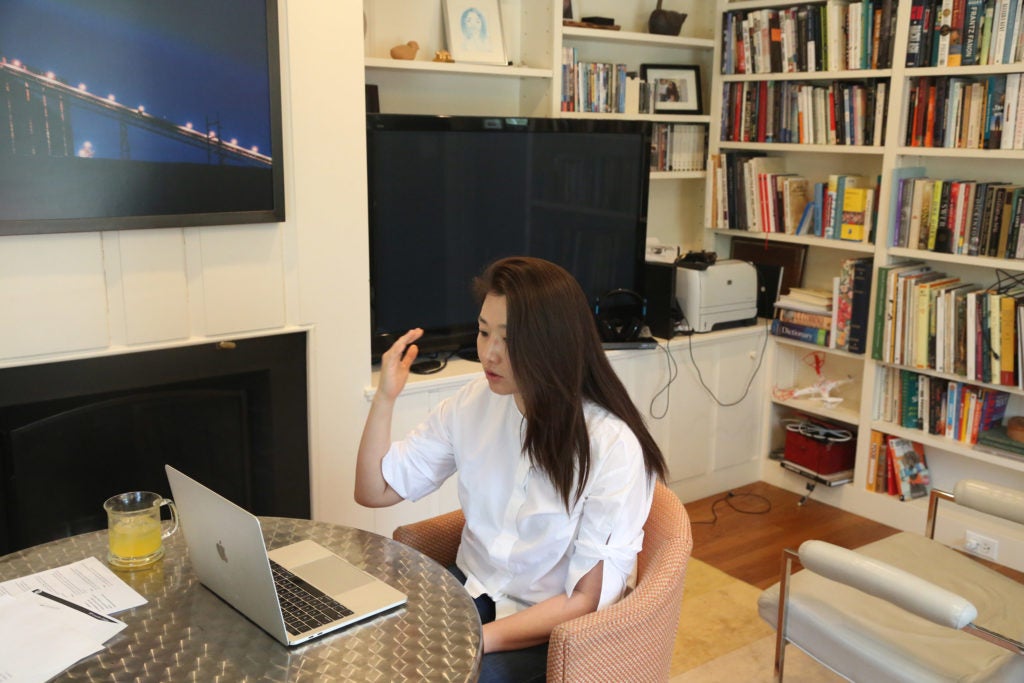
The extraordinary circumstances also offered unexpected pedagogical opportunities. After the U.S. Supreme Court postponed its oral arguments for March because of the pandemic, Suk had her constitutional law class, which focused on the separation of powers, federalism and the 14th Amendment, hold a mock oral argument in Trump v. Vance. Students played the roles of the attorneys and justices. The experiment, she wrote, “showed that it was totally viable to have court hearings online during a lockdown, even for the highest court in the land.” (In May, the high court held oral arguments via teleconference but without video cameras.)
Crespo redesigned a week in his 1L Criminal Law course to incorporate the pandemic. “We juxtaposed the order-maintenance policing that happens all the time with the idea of role of the state in maintaining order when key portions of society are in a state of crisis,” he said. And instead of his usual Socratic questioning, Crespo divided students into small groups who took on different roles—police officers, prosecutors, prison officials—as the class discussed stay-at-home orders and the unique epidemiological risks of pandemics in prisons.
Professor Laurence Tribe had designed his seminar to parallel current events related to the U.S. presidency and the Department of Justice. The COVID-19 crisis took the lessons to new levels.
Before the pandemic, Professor Laurence Tribe ’66 designed his seminar, Defending Constitutional Democracy, to parallel current events related to the U.S. presidency and the Department of Justice. The COVID-19 crisis took the lessons to new levels. “The very fact the class had to be taught in a different way reinforced the evolving nature of the subject matter,” said Tribe. “If anything, [the course] was improved by the fact we were doing in real time some of what the whole country was having to do.”
Tribe added, “It was kind of odd it was virtual because it was realer than education often is.” The federal government’s response to the emergency “related to legal doctrines the students were already studying.”
In a survey of HLS students by the administration about the quality of online education in spring 2020, the mean, across a broad range of course offerings, was encouraging. For example, on a five-point scale, it was 4.03 for 1L courses, 4.38 for large upper-level courses, 4.40 for clinics, and 4.44 for seminars and reading groups.
Though she’d had some misgivings about the shift to online teaching and learning, Skillings noted that it went much better than she’d expected, particularly Professor Crespo’s class: “I don’t think he dialed back the energy at all [and] it ended up being really, really engaging.”
Given that faculty had moved online virtually overnight, the spring experience “provides a solid base for what we can accomplish with even more lead time,” said Professor and Deputy Dean I. Glenn Cohen ’03.
Cohen is co-chair of the Online Teaching Working Group, appointed by Dean John F. Manning ’85 in mid-April, which is co-chaired by Associate Dean and Dean for Academic and Faculty Affairs Catherine Claypoole LL.M. ’98 and includes Professors Christopher Bavitz, Molly Brady, William Fisher ’82, Crystal Yang ’13, and Interim Associate Dean for Student Services Jessica Soban ’07. They are developing best teaching and learning practices from a broad variety of sources including the Harvard Graduate School of Education.
A faculty working group has been developing best online teaching and learning practices from a broad variety of sources.
The working group is considering a variety of tools to enhance online learning, such as supplementing the Socratic method with small breakout groups for discussions. There may be more transparency and clarity about where exactly a class is headed on a given day and over the course of the semester, and more focus on pre- and post-class work including student discussion groups, Cohen says. Alumni may be invited to record interviews about their personal experiences with key cases that students are studying. The use of pre-class discussion threads and the online polling function may enable teachers to create a rich feedback loop about what students find most challenging, what they think is interesting and worth exploring, and what creative ideas they have about framing a topic. In addition, these new approaches may foster discussion about and debate over the subject matter. The development of online learning at HLS is also being supported by Leah Plunkett ’06, who joins the school this fall as head of the new Learning Experience & Technology group, or LXT.
“The school is prepared not just to teach online but to provide excellent, HLS-quality teaching.”
One of the things Cohen and his colleagues have been thinking about is how to make the most of this unique, albeit challenging, moment. “Our faculty are committed to being the best teachers we can be. Preparing high-quality online courses has inspired the HLS faculty to engage in rich discussions and share creative ideas about our pedagogy and will also undoubtedly create additional opportunities for innovation when we return to campus,” he said. “The dean’s view and mine too is that the school is prepared not just to teach online but to provide excellent, HLS-quality teaching.”
On June 3, Dean Manning announced that the fall term at HLS will be held online. “This is not the announcement we’d hoped to make,” he wrote in a statement to the HLS community. “But our first priority is, and must continue to be, the health and safety of our community, and we cannot reliably conclude at this time that we can safely provide an effective on-campus program this fall.”
This past semester required quick adaptation to a new format, Manning wrote. “This coming semester, though, asks something different of us,” he continued, “to use technology to design even more creative, exciting, and excellent experiences in support of learning, building community, and engaging in the service that helps those most in need and that is fundamental to the work lawyers do.”
“Despite the incredibly challenging circumstances that I know the students were facing, they brought an inspiring degree of commitment, diligence, preparation and enthusiasm to every class session.”
The experience so far has already provided evidence that distance learning need not be antithetical to the dean’s goal of building community. Crespo reflected: “I was teaching over 200 students this semester, and they were amazing. Despite the incredibly challenging circumstances that I know many of them were facing, they brought an inspiring degree of commitment, diligence, preparation and enthusiasm to every class session. Week in and week out, I felt so lucky to be connected to this rich intellectual community as the rest of the world was sheltering in place.”
He continued: “In the last few minutes of the last class with my 1Ls, I got unexpectedly choked up. I don’t think it hit me until it was time to say goodbye just how very much I was going to miss them. This semester more than any other, I had really come to look forward to our four hours together each week, a time when we came together—from all over the country and all around the world—to learn together and to enjoy each other’s company.”
